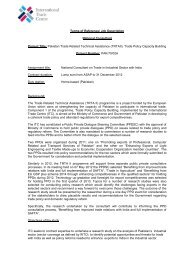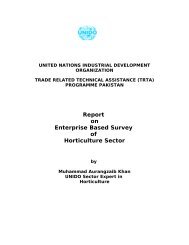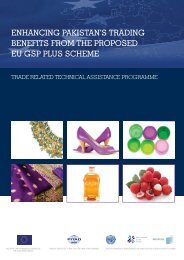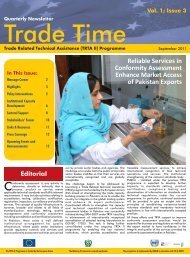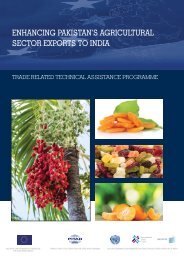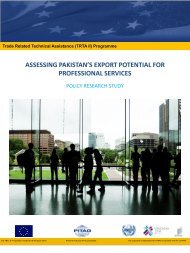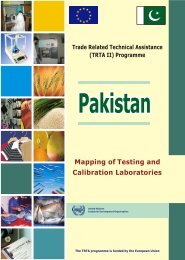Enhancing dairy sector export competitiveness - International Trade ...
Enhancing dairy sector export competitiveness - International Trade ...
Enhancing dairy sector export competitiveness - International Trade ...
You also want an ePaper? Increase the reach of your titles
YUMPU automatically turns print PDFs into web optimized ePapers that Google loves.
ENHANCING DAIRY SECTOR EXPORT COMPETITIVENESS IN PAKISTANcompletion and for the provision of high quality semen doses. 111 This initiative can potentiallylead to the <strong>export</strong> of semen doses as there is demand for indigenous breed in the internationalmarkets as per industry and governmental sources.Feed and Nutritional Management(i)(ii)(iii)(iv)(v)(vi)Currently imported feed prices are quite low as compared to the ones locally produced.According to industry estimates, 1 kg of imported corn feed costs PKR 20 (USD 0.2) ascompared to local corn feed at PKR 30 (USD 0.2). This price difference makes a huge impacton the small-scale farmer. 112 Therefore the government should continue its policy of openingup imports of all required types of feed and zero-rate them as much as possible. 113To cater to the large domestic demand of animals feed and fodder and to decrease the price ofhigh quality concentrates produced locally, the government needs to encourage privateinvestment in this industry. There is high potential to earn profits by the private <strong>sector</strong> in silageproduction due to increased efficiency as even the government is earning profits on its silageproduction project. 114Simultaneously, the spreading of awareness amongst the farmers’ community is an importantaspect of making them realize the importance of providing nutritional values to the milchanimals and in order to get more production from them and therefore become commerciallyand economically better off. 115 The same can be ensured in the <strong>dairy</strong> hubs through theprovision of low-cost technology, silage production training and imparting relevant knowledgeto the opinion leaders and progressive-minded farmers in the villages. 116As value of land is very high, government may lease land on reasonable rates to farmersinterested in growing crop for fodder. Based on the huge gap in the demand and supply offeed, there is a very profitable opportunity for competition in the industry.A national strategy is required to be adopted where awareness programmes should belaunched for the farmers on the importance of food and nutrition according the Total MixedRation (TMR) technique. 117The root cause of lack of proper feed and nutrition and water supplies provided by small-scalefarmers is their unawareness of its impact on the animal welfare. These can only be overcomethrough model practises in the <strong>dairy</strong> hubs. For example, the acceptability of silage productionand provision was very low amongst the small-scale farmers, however, under the Dairy Hubconcept by Tetra Pak, when farmers were made aware of the nature of feed, methods of itsproduction, and consequential benefits of increasing their animals’ productivity motivated themto use silage instantly. In another incidence, when farmers were taught the importance ofkeeping their animals loose to reach available water sources on their own and as per theirnatural requirement, its adoption resulted in an instant increase in the milk productivity of theiranimals by 1 litre each. 118111 Punjab Livestock and Dairy Development Board (PLDDB) and Punjab Board of Investment and <strong>Trade</strong> (PBIT) would be required totake a proactive role in this aspect.112 According to government estimates, about 25 kg of silage is required to fulfil the daily dietary requirements of 1 mature milchanimal113 SMEDA114 The cost of production of 1 kg currently stands at PKR 5, while it is being priced at PKR 6.5 (Corn Silage) and PKR 7 (WheatSilage) to cater to the local farmers, especially when there is a shortage in local fodder production during the winter months. Thecosts do not include depreciation on the imported machinery and the profits are being reinvested into the project. (Source: PunjabLivestock and Dairy Development Board (PLDDB)115 Local farmers generally provide low cost wheat straw to their animals which has very low nutritive value and a subsequent negativeeffect on their productivity levels. (Small and Medium Enterprises Development Authority, SMEDA and Punjab Livestock and DairyDevelopment Board, PLDDB)117TMR ensures that the daily feed quantity provided to the animal should be 3-3.5% of its weight to acquire maximum productivity.118 Solve Agri Pak (Private) Limited75



